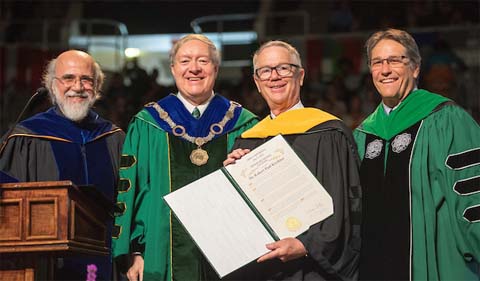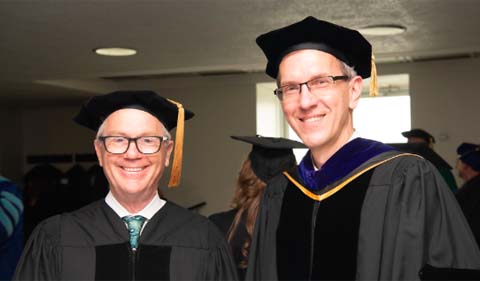
World-renowned astronomer, Dr. Robert Kirshner (holding degree) received an honorary degree at Graduate Commencement ceremonies. (L-R): Executive Vice President and Provost Dr. Chaden Djalali, President Dr. M. Duane Nellis, Dr. Kirshner, Chair of Ohio University Board of Trustees Dr. David Scholl. Photo by Ben Siegel
Ohio University President M. Duane Nellis conferred an OHIO Honorary Doctor of Science upon Dr. Robert P. Kirshner.
Kirshner is Clowes Research Professor of Science at Harvard University and Chief Program Officer for Science at the Gordon & Betty Moore Foundation, where he leads a team responsible for distributing more than $100 million per year for research and technology to enable fundamental scientific discoveries.
“In his research he has made groundbreaking contributions in several areas of astronomy, including the physics of exploding stars seen as supernovae, supernova remnants, and the large-scale structure of the universe. Kirshner has been a leader in the effort to use supernovae to study cosmic expansion, resulting in the discovery that the expansion of the universe is accelerating over time, driven by a mysterious dark energy that has emerged as a new focus of intense inquiry in the scientific community,” Dr. Nellis noted at OHIO’s May 3 Graduate Commencement.

From left, Dr. Robert Kirshner and Dr. Joe Shields, Interim Dean of the College of Arts & Sciences. Photos by Ben Siegel
“This work has received numerous recognitions and we are honored to add an Ohio University Honorary Degree to his listing of honors.”
OHIO Executive Vice President and Provost Dr. Chaden Djalali read the honorary degree citation:
Dr. Robert Paul Kirshner: As a world-renown astronomer, you have made groundbreaking contributions in several areas of astronomy, including the physics of exploding stars seen as supernovae, supernova remnants, the large-scale structure of the cosmos, and the use of supernovae to measure the expansion of the universe.
In your doctoral dissertation, you launched the field of distance determinations for supernovae based on spectroscopic measurements and physical models of exploding sources. You led the study of the nearest supernova in several millennia, Supernova 1987A in our neighbor galaxy, the Large Magellanic Cloud, using NASA’s International Ultraviolet Explorer and Hubble Space Telescope. The results from your work have spurred major advances in the world’s understanding of the evolution of massive stars. You were also part of a team that provided one of the first demonstrations in 1981 of large-scale inhomogeneity in the distribution of matter in the universe, manifesting itself as voids in the distribution of galaxies.
You led the effort to use supernovae to map the large-scale geometry of the universe, resulting in the discovery that the expansion of the universe is accelerating over time, driven by a mysterious dark energy that is now recognized as the dominant form of matter/energy in the universe. The discovery of cosmic acceleration was named by Science Magazine as the “Breakthrough of the Year” in 1998 and was recognized with the award of the 2011 Nobel Prize in Physics to three scientists, two of whom were your former students.
You are an elected member of the National Academy of Sciences and the American Academy of Arts and Sciences. Your research accomplishments have been recognized with the Gruber Prize in Cosmology, the Dannie Heineman Prize from the American Institute of Physics, the James Craig Watson Medal from the National Academy of Sciences, and the Wolf Prize in Physics.


















Comments